Synthesis and Characterization of Fe-TiO2 Nanomaterial: Performance Evaluation for RB5 Decolorization and In Vitro Antibacterial Studies
Abstract
1. Introduction
2. Materials and Methods
2.1. Materials
2.2. Synthesis of TiO2 and Fe-TiO2 Photocatalysts
2.3. Photocatalyst Characterization
2.4. RB5 Decolorization
2.5. Optimization Studies
2.6. Adsorption Isotherms
2.7. Photocatalytic Kinetics
2.8. Photocatalytic Disinfection Performance Evaluation
2.9. Energy Efficiency and Cost Analysis
3. Result and Discussion
3.1. Thermal Analysis
3.2. Functional Group Identification
3.3. X-ray Diffraction Analysis
3.4. Scanning Electron Microscopy (SEM) and Transmission Electron Microscopy (TEM) Analyses
3.5. Bandgap Analysis
3.6. BET Analysis
3.7. Photodecolorization Studies
3.7.1. Effect of Photocatalyst Dose
3.7.2. Effect of Reaction pH
3.7.3. Effect of Initial Dye Concentration
3.7.4. Fe-TiO2 Adsorption Studies
3.8. Heterogenous Photocatalytic Kinetic Studies for Iron Doped TiO2 Photocatalysts
3.9. TOC Analysis
3.10. Photocatalytic Disinfection Performance Evaluation
3.11. Energy Efficiency Analysis
4. Conclusions
Supplementary Materials
Author Contributions
Funding
Conflicts of Interest
Appendix A. Effect of Calcination Temperature and Iron Loading
| Photocatalyst | Calcination Temperature (°C) | ||
|---|---|---|---|
| 200 °C | 300 °C | 400 °C | |
| 0.0Fe-TiO2 | 40.16 | 47.73 | 28.35 |
| 0.01Fe-TiO2 | 74.46 | 76.11 | 70.37 |
| 0.05Fe-TiO2 | 78.64 | 82.31 | 79.45 |
| 0.1Fe-TiO2 | 86.63 | 91.06 | 88.63 |
| 0.5Fe-TiO2 | 79.13 | 86.80 | 84.01 |
| 1.0Fe-TiO2 | 69.53 | 83.39 | 80.72 |
| 5.0Fe-TiO2 | 61.30 | 79.30 | 75.97 |
References
- Favero, B.M.; Favero, A.C.; Taffarel, S.R.; Souza, F.S. Evaluation of the efficiency of coagulation/flocculation and Fenton process in reduction of colour, turbidity and COD of a textile effluent. Environ. Technol. 2020, 41, 1580–1589. [Google Scholar] [CrossRef] [PubMed]
- Balcik-Canbolat, C.; Sengezer, C.; Sakar, H.; Karagunduz, A.; Keskinler, B. A study on near zero liquid discharge approach for the treatment of reverse osmosis membrane concentrate by electrodialysis. Environ. Technol. 2020, 41, 440–449. [Google Scholar] [CrossRef]
- Desa, A.; Dahlan, D.; Misdan, N.; Abu Bakar Sidik, D.; Hairom, N.; Leman, A.; Abdullahi, T.; Harun, Z.; Yusof, N. A Comparative Study of Direct Ultrafiltration Process and Membrane Photocatalytic Reactor System for Textile Wastewater Treatment. Res. J. Chem. Environ. 2020, 24, 5. [Google Scholar]
- Shah, J.A.; Butt, T.A.; Mirza, C.R.; Shaikh, A.J.; Khan, M.S.; Arshad, M.; Riaz, N.; Haroon, H.; Gardazi, S.M.H.; Yaqoob, K. Phosphoric Acid Activated Carbon from Melia azedarach Waste Sawdust for Adsorptive Removal of Reactive Orange 16: Equilibrium Modelling and Thermodynamic Analysis. Molecules 2020, 25, 2118. [Google Scholar] [CrossRef] [PubMed]
- Haroon, H.; Shah, J.A.; Khan, M.S.; Alam, T.; Khan, R.; Asad, S.A.; Ali, M.A.; Farooq, G.; Iqbal, M.; Bilal, M. Activated carbon from a specific plant precursor biomass for hazardous Cr(VI) adsorption and recovery studies in batch and column reactors: Isotherm and kinetic modeling. J. Water Process Eng. 2020, 38, 101577. [Google Scholar] [CrossRef]
- Misra, M.; Akansha, K.; Sachan, A.; Sachan, S.G. Removal of Dyes from Industrial Effluents by Application of Combined Biological and Physicochemical Treatment Approaches. In Combined Application of Physico-Chemical & Microbiological Processes for Industrial Effluent Treatment Plant; Springer: Berlin/Heidelberg, Germany, 2020; pp. 365–407. [Google Scholar]
- Ijanu, E.; Kamaruddin, M.; Norashiddin, F. Coffee processing wastewater treatment: A critical review on current treatment technologies with a proposed alternative. Appl. Water Sci. 2020, 10, 11. [Google Scholar] [CrossRef]
- Riaz, N.; Hassan, M.; Siddique, M.; Mahmood, Q.; Farooq, U.; Sarwar, R.; Khan, M.S. Photocatalytic degradation and kinetic modeling of azo dye using bimetallic photocatalysts: Effect of synthesis and operational parameters. Environ. Sci. Pollut. Res. 2020, 27, 2992–3006. [Google Scholar] [CrossRef] [PubMed]
- Khan, M.S.; Kait, C.F.; Mutalib, M.I.A. Photooxidative desulfurization for diesel using Fe/N−TiO2 photocatalyst. In AIP Conference Proceedings; American Institute of Physics: College Park, MD, USA, 2014; Volume 1621, pp. 10–16. [Google Scholar]
- Riaz, N.; Mohamad Azmi, B.-K.; Mohd Shariff, A. Iron doped TiO2 photocatalysts for environmental applications: Fundamentals and progress. In Advanced Materials Research; Trans Tech Publications Ltd.: Freienbach, Switzerland, 2014; Volume 925, pp. 689–693. [Google Scholar]
- Cheng, G.; Liu, X.; Song, X.; Chen, X.; Dai, W.; Yuan, R.; Fu, X. Visible-light-driven deep oxidation of NO over Fe doped TiO2 catalyst: Synergic effect of Fe and oxygen vacancies. Appl. Catal. B Environ. 2020, 277, 119196. [Google Scholar] [CrossRef]
- Zhang, Y.; Shen, Y.; Gu, F.; Wu, M.; Xie, Y.; Zhang, J. Influence of Fe ions in characteristics and optical properties of mesoporous titanium oxide thin films. Appl. Surf. Sci. 2009, 256, 85–89. [Google Scholar] [CrossRef]
- Vijayalakshmi, K.; Jereil, S.D. Influence of Fe catalytic doping on the properties of TiO2 nanoparticles synthesized by microwave method. J. Mater. Sci. Mater. Electron. 2014, 25, 5089–5094. [Google Scholar] [CrossRef]
- Soo, C.W.; Juan, J.C.; Lai, C.W.; Hamid, S.B.A.; Yusop, R.M. Fe-doped mesoporous anatase-brookite titania in the solar-light-induced photodegradation of Reactive Black 5 dye. J. Taiwan Inst. Chem. Eng. 2016, 68, 153–161. [Google Scholar] [CrossRef]
- Zhu, J.; Chen, F.; Zhang, J.; Chen, H.; Anpo, M. Fe3+-TiO2 photocatalysts prepared by combining sol–gel method with hydrothermal treatment and their characterization. J. Photochem. Photobiol. A Chem. 2006, 180, 196–204. [Google Scholar] [CrossRef]
- Komaraiah, D.; Radha, E.; Kalarikkal, N.; Sivakumar, J.; Ramana Reddy, M.V.; Sayanna, R. Structural, optical and photoluminescence studies of sol-gel synthesized pure and iron doped TiO2 photocatalysts. Ceram. Int. 2019, 45, 25060–25068. [Google Scholar] [CrossRef]
- Siti Aida, I.; Abdul Hadi Zainal, A.; Rosniza, H.; Zakiah, K.; Mohamed Nasrul Mohamed, H.; Ainun Rahmahwati, A.; Muhamad Zaini, Y. Effect of Calcination Temperature on (N, Fe) Doped TiO2 Nanoparticles. J. Sci. Technol. 2018, 10, 44–48. [Google Scholar]
- Faisal, A.Q.D. Synthesis and characteristics study of TiO 2 nanowires and nanoflowers on FTO/glass and glass substrates via hydrothermal technique. J. Mater. Sci. Mater. Electron. 2015, 26, 317–321. [Google Scholar]
- Ranjit, K.T.; Viswanathan, B. Synthesis, characterization and photocatalytic properties of iron-doped TiO2 catalysts. J. Photochem. Photobiol. A Chem. 1997, 108, 79–84. [Google Scholar] [CrossRef]
- Lucas, M.S.; Tavares, P.B.; Peres, J.A.; Faria, J.L.; Rocha, M.; Pereira, C.; Freire, C. Photocatalytic degradation of Reactive Black 5 with TiO2-coated magnetic nanoparticles. Catal. Today 2013, 209, 116–121. [Google Scholar] [CrossRef]
- Ismael, M. Enhanced photocatalytic hydrogen production and degradation of organic pollutants from Fe (III) doped TiO2 nanoparticles. J. Environ. Chem. Eng. 2020, 8, 103676. [Google Scholar] [CrossRef]
- Ranganayaki, T.; Venkatachalam, M.; Vasuki, T.; Shankar, S. Preparation and characterization of nanocrystalline TiO2 thin films prepared by sol–gel spin-coating method. Int. J. Innov. Res. Sci. Eng. Technol. 2014, 3, 16707–16713. [Google Scholar]
- Al-Jawad, S.M.H.; Taha, A.A.; Salim, M.M. Synthesis and characterization of pure and Fe doped TiO2 thin films for antimicrobial activity. Optik 2017, 142, 42–53. [Google Scholar] [CrossRef]
- Hossain, M.A.; Elias, M.; Sarker, D.R.; Diba, Z.R.; Mithun, J.M.; Azad, M.A.K.; Siddiquey, I.A.; Rahman, M.M.; Uddin, J.; Uddin, M.N. Synthesis of Fe- or Ag-doped TiO2–MWCNT nanocomposite thin films and their visible-light-induced catalysis of dye degradation and antibacterial activity. Res. Chem. Intermed. 2018, 44, 2667–2683. [Google Scholar] [CrossRef]
- Yadav, H.M.; Kolekar, T.V.; Pawar, S.H.; Kim, J.-S. Enhanced photocatalytic inactivation of bacteria on Fe-containing TiO2 nanoparticles under fluorescent light. J. Mater. Sci. Mater. Med. 2016, 27, 57. [Google Scholar] [CrossRef]
- Delekar, S.D.; Yadav, H.M.; Achary, S.N.; Meena, S.S.; Pawar, S.H. Structural refinement and photocatalytic activity of Fe-doped anatase TiO2 nanoparticles. Appl. Surf. Sci. 2012, 263, 536–545. [Google Scholar] [CrossRef]
- Wang, S.; Lian, J.S.; Zheng, W.T.; Jiang, Q. Photocatalytic property of Fe doped anatase and rutile TiO2 nanocrystal particles prepared by sol–gel technique. Appl. Surf. Sci. 2012, 263, 260–265. [Google Scholar] [CrossRef]
- Subramaniam, M.N.; Goh, P.S.; Lau, W.J.; Ismail, A.F.; Karaman, M. Enhanced visible light photocatalytic degradation of organic pollutants by iron doped titania nanotubes synthesized via facile one-pot hydrothermal. Powder Technol. 2020, 366, 96–106. [Google Scholar] [CrossRef]
- Liu, J.; Zhang, Z.; Yang, L.; Zhang, Y.; Deng, S. The degradation of reactive black wastewater by Fe/Cu co-doped TiO2. Int. J. Chem. 2011, 3, 87–93. [Google Scholar] [CrossRef]
- Iftikhar, A.; Khan, M.S.; Rashid, U.; Mahmood, Q.; Zafar, H.; Bilal, M.; Riaz, N. Influence of metallic species for efficient photocatalytic water disinfection: Bactericidal mechanism of in vitro results using docking simulation. Env. Sci. Pollut. Res. Int. 2020, 27, 39819–39831. [Google Scholar] [CrossRef]
- Lam, S.-M.; Quek, J.-A.; Sin, J.-C. Mechanistic investigation of visible light responsive Ag/ZnO micro/nanoflowers for enhanced photocatalytic performance and antibacterial activity. J. Photochem. Photobiol. A Chem. 2018, 353, 171–184. [Google Scholar] [CrossRef]
- Antonelli, D.M.; Ying, J.Y. Synthesis of hexagonally packed mesoporous TiO2 by a modified sol–gel method. Angew. Chem. Int. Ed. Engl. 1995, 34, 2014–2017. [Google Scholar] [CrossRef]
- Riaz, N.; Chong, F.K.; Dutta, B.K.; Man, Z.B.; Khan, M.S.; Nurlaela, E. Photodegradation of Orange II under visible light using Cu-Ni/TiO2: Effect of calcination temperature. Chem. Eng. J. 2012, 185, 108–119. [Google Scholar] [CrossRef]
- Langford, J.I.; Wilson, A. Scherrer after sixty years: A survey and some new results in the determination of crystallite size. J. Appl. Crystallogr. 1978, 11, 102–113. [Google Scholar] [CrossRef]
- Houas, A.; Lachheb, H.; Ksibi, M.; Elaloui, E.; Guillard, C.; Herrmann, J.-M. Photocatalytic degradation pathway of methylene blue in water. Appl. Catal. B Environ. 2001, 31, 145–157. [Google Scholar] [CrossRef]
- Khan, M.S.; Shah, J.A.; Arshad, M.; Halim, S.A.; Khan, A.; Shaikh, A.J.; Riaz, N.; Khan, A.J.; Arfan, M.; Shahid, M.; et al. Photocatalytic decolorization and biocidal applications of nonmetal doped TiO2: Isotherm, kinetic modeling and In Silico molecular docking studies. Molecules 2020, 25, 4468. [Google Scholar] [CrossRef] [PubMed]
- Azbar, N.; Yonar, T.; Kestioglu, K. Comparison of various advanced oxidation processes and chemical treatment methods for COD and color removal from a polyester and acetate fiber dyeing effluent. Chemosphere 2004, 55, 35–43. [Google Scholar] [CrossRef] [PubMed]
- Šijaković-Vuji, N.; Gotić, M.; Musić, S.; Ivanda, M.; Popović, S. Synthesis and microstructural properties of Fe-TiO2 nanocrystalline particles obtained by a modified sol-gel method. J. Sol-Gel Sci. Technol. 2004, 30, 5–19. [Google Scholar] [CrossRef]
- Ali, T.; Tripathi, P.; Azam, A.; Raza, W.; Ahmed, A.S.; Ahmed, A.; Muneer, M. Photocatalytic performance of Fe-doped TiO2 nanoparticles under visible-light irradiation. Mater. Res. Express 2017, 4, 015022. [Google Scholar] [CrossRef]
- Solano Pizarro, R.A.; Herrera Barros, A.P. Cypermethrin elimination using Fe-TiO2 nanoparticles supported on coconut palm spathe in a solar flat plate photoreactor. Adv. Compos. Lett. 2020, 29, 1–13. [Google Scholar] [CrossRef]
- Abdelhaleem, A.; Chu, W.; Liang, X. Diphenamid degradation via sulfite activation under visible LED using Fe (III) impregnated N-doped TiO2 photocatalyst. Appl. Catal. B Environ. 2019, 244, 823–835. [Google Scholar] [CrossRef]
- Riaz, N.; Chong, F.K.; Dutta, B.K.; Man, Z.B.; Khan, M.S.; Nurlaela, E. Effect of calcination temperature on Orange II photocatalytic degradation using Cu:Ni/TiO2 under visible light. In Proceedings of the 2011 National Postgraduate Conference, Perak, Malaysia, 19–20 September 2011; pp. 1–5. [Google Scholar]
- Devi, L.G.; Anitha, B. Exploration of vectorial charge transfer mechanism in TiO2/SrTiO3 composite under UV light illumination for the degradation of 4-Nitrophenol: A comparative study with TiO2 and SrTiO3. Surf. Interfaces 2018, 11, 48–56. [Google Scholar] [CrossRef]
- Solano, R.A.; Herrera, A.P.; Maestre, D.; Cremades, A. Fe-TiO2 Nanoparticles Synthesized by Green Chemistry for Potential Application in Waste Water Photocatalytic Treatment. J. Nanotechnol. 2019, 2019, 4571848. [Google Scholar] [CrossRef]
- Wantala, K.; Laokiat, L.; Khemthong, P.; Grisdanurak, N.; Fukaya, K. Calcination temperature effect on solvothermal Fe–TiO2 and its performance under visible light irradiation. J. Taiwan Inst. Chem. Eng. 2010, 41, 612–616. [Google Scholar] [CrossRef]
- Dahman, Y.; Hoda, Javaheri; Jiafu, Chen; Basel Al-Chikh, Sulaiman. Nanoparticles. In Nanotechnology and Functional Materials for Engineers; Dahman, Y., Ed.; Elsevier: Amsterdam, The Netherlands, 2017; pp. 93–119. [Google Scholar] [CrossRef]
- Cheng, X.; Yu, X.; Xing, Z.; Yang, L. Synthesis and characterization of N-doped TiO2 and its enhanced visible-light photocatalytic activity. Arab. J. Chem. 2016, 9, S1706–S1711. [Google Scholar] [CrossRef]
- Tauc, J. Optical properties of amorphous semiconductors. In Amorphous and Liquid Semiconductors; Springer: Berlin/Heidelberg, Germany, 1974; pp. 159–220. [Google Scholar]
- Almquist, C.B.; Biswas, P. Role of synthesis method and particle size of nanostructured TiO2 on its photoactivity. J. Catal. 2002, 212, 145–156. [Google Scholar] [CrossRef]
- Wang, Z.; Cai, W.; Hong, X.; Zhao, X.; Xu, F.; Cai, C. Photocatalytic degradation of phenol in aqueous nitrogen-doped TiO2 suspensions with various light sources. Appl. Catal. B Environ. 2005, 57, 223–231. [Google Scholar] [CrossRef]
- Moradi, V.; Ahmed, F.; Jun, M.B.; Blackburn, A.; Herring, R.A. Acid-treated Fe-doped TiO2 as a high performance photocatalyst used for degradation of phenol under visible light irradiation. J. Environ. Sci. 2019, 83, 183–194. [Google Scholar] [CrossRef] [PubMed]
- Ambati, R.; Gogate, P.R. Photocatalytic degradation of Acid Blue 80 using iron doped TiO2 catalyst: Understanding the effect of operating parameters and combinations for synergism. J. Water Process Eng. 2017, 20, 217–225. [Google Scholar] [CrossRef]
- Kalantary, R.R.; Dadban Shahamat, Y.; Farzadkia, M.; Esrafili, A.; Asgharnia, H. Photocatalytic degradation and mineralization of diazinon in aqueous solution using nano-TiO2 (Degussa, P25): Kinetic and statistical analysis. Desalination Water Treat. 2015, 55, 555–563. [Google Scholar] [CrossRef]
- Kansal, S.K.; Ali, A.H.; Kapoor, S. Photocatalytic decolorization of biebrich scarlet dye in aqueous phase using different nanophotocatalysts. Desalination 2010, 259, 147–155. [Google Scholar] [CrossRef]
- Chen, D.; Ray, A.K. Photodegradation kinetics of 4-nitrophenol in TiO2 suspension. Water Res. 1998, 32, 3223–3234. [Google Scholar] [CrossRef]
- Eslami, A.; Amini, M.M.; Yazdanbakhsh, A.R.; Mohseni-Bandpei, A.; Safari, A.A.; Asadi, A. N, S co-doped TiO2 nanoparticles and nanosheets in simulated solar light for photocatalytic degradation of non-steroidal anti-inflammatory drugs in water: A comparative study. J. Chem. Technol. Biotechnol. 2016, 91, 2693–2704. [Google Scholar] [CrossRef]
- Tabasideh, S.; Maleki, A.; Shahmoradi, B.; Ghahremani, E.; McKay, G. Sonophotocatalytic degradation of diazinon in aqueous solution using iron-doped TiO2 nanoparticles. Sep. Purif. Technol. 2017, 189, 186–192. [Google Scholar] [CrossRef]
- Isari, A.A.; Payan, A.; Fattahi, M.; Jorfi, S.; Kakavandi, B. Photocatalytic degradation of rhodamine B and real textile wastewater using Fe-doped TiO2 anchored on reduced graphene oxide (Fe-TiO2/rGO): Characterization and feasibility, mechanism and pathway studies. Appl. Surf. Sci. 2018, 462, 549–564. [Google Scholar] [CrossRef]
- Gupta, V.K.; Jain, R.; Mittal, A.; Saleh, T.A.; Nayak, A.; Agarwal, S.; Sikarwar, S. Photo-catalytic degradation of toxic dye amaranth on TiO2/UV in aqueous suspensions. Mater. Sci. Eng. C 2012, 32, 12–17. [Google Scholar] [CrossRef] [PubMed]
- Gar Alalm, M.; Tawfik, A.; Ookawara, S. Comparison of solar TiO2 photocatalysis and solar photo-Fenton for treatment of pesticides industry wastewater: Operational conditions, kinetics, and costs. J. Water Process Eng. 2015, 8, 55–63. [Google Scholar] [CrossRef]
- Çınar, S.; Kaynar, Ü.H.; Aydemir, T.; Çam Kaynar, S.; Ayvacıklı, M. An efficient removal of RB5 from aqueous solution by adsorption onto nano-ZnO/Chitosan composite beads. Int. J. Biol. Macromol. 2017, 96, 459–465. [Google Scholar] [CrossRef]
- Shaheed, M.A.; Hussein, F.H. Adsorption of Reactive Black 5 on Synthesized Titanium Dioxide Nanoparticles: Equilibrium Isotherm and Kinetic Studies. J. Nanomater. 2014, 2014, 198561. [Google Scholar] [CrossRef]
- Gupta, V.K.; Eren, T.; Atar, N.; Yola, M.L.; Parlak, C.; Karimi-Maleh, H. CoFe2O4@TiO2 decorated reduced graphene oxide nanocomposite for photocatalytic degradation of chlorpyrifos. J. Mol. Liq. 2015, 208, 122–129. [Google Scholar] [CrossRef]
- Ghasemi, Z.; Seif, A.; Ahmadi, T.S.; Zargar, B.; Rashidi, F.; Rouzbahani, G.M. Thermodynamic and kinetic studies for the adsorption of Hg(II) by nano-TiO2 from aqueous solution. Adv. Powder Technol. 2012, 23, 148–156. [Google Scholar] [CrossRef]
- Šegota, S.; Ćurković, L.; Ljubas, D.; Svetličić, V.; Houra, I.F.; Tomašić, N. Synthesis, characterization and photocatalytic properties of sol–gel TiO2 films. Ceram. Int. 2011, 37, 1153–1160. [Google Scholar] [CrossRef]
- Jawad, A.H.; Mubarak, N.S.A.; Ishak, M.A.M.; Ismail, K.; Nawawi, W.I. Kinetics of photocatalytic decolourization of cationic dye using porous TiO2 film. J. Taibah Univ. Sci. 2016, 10, 352–362. [Google Scholar] [CrossRef]
- Kumar, P.S.S.; Sivakumar, R.; Anandan, S.; Madhavan, J.; Maruthamuthu, P.; Ashokkumar, M. Photocatalytic degradation of Acid Red 88 using Au–TiO2 nanoparticles in aqueous solutions. Water Res. 2008, 42, 4878–4884. [Google Scholar] [CrossRef]
- Rodríguez, P.A.O.; Pecchi, G.A.; Casuscelli, S.G.; Elías, V.R.; Eimer, G.A. A simple synthesis way to obtain iron-doped TiO2 nanoparticles as photocatalytic surfaces. Chem. Phys. Lett. 2019, 732, 136643. [Google Scholar] [CrossRef]
- Kumar, K.V.; Porkodi, K.; Rocha, F. Langmuir–Hinshelwood kinetics – A theoretical study. Catal. Commun. 2008, 9, 82–84. [Google Scholar] [CrossRef]
- Riaz, N.; Kait, C.F.; Man, Z.; Dutta, B.K.; Ramli, R.M.; Khan, M.S. Visible light photodegradation of azo dye by Cu/TiO2. Adv. Mater. Res. 2014, 917, 151–159. [Google Scholar] [CrossRef]
- Lin, L.; Wang, H.; Luo, H.; Xu, P. Enhanced photocatalysis using side-glowing optical fibers coated with Fe-doped TiO2 nanocomposite thin films. J. Photochem. Photobiol. A Chem. 2015, 307–308, 88–98. [Google Scholar] [CrossRef]
- Lin, C.J.; Liou, Y.H.; Zhang, Y.; Chen, C.L.; Dong, C.-L.; Chen, S.-Y.; Stucky, G.D. Mesoporous Fe-doped TiO2 sub-microspheres with enhanced photocatalytic activity under visible light illumination. Appl. Catal. B Environ. 2012, 127, 175–181. [Google Scholar] [CrossRef]
- Ambati, R.; Gogate, P.R. Ultrasound assisted synthesis of iron doped TiO2 catalyst. Ultrason. Sonochemistry 2018, 40, 91–100. [Google Scholar] [CrossRef]
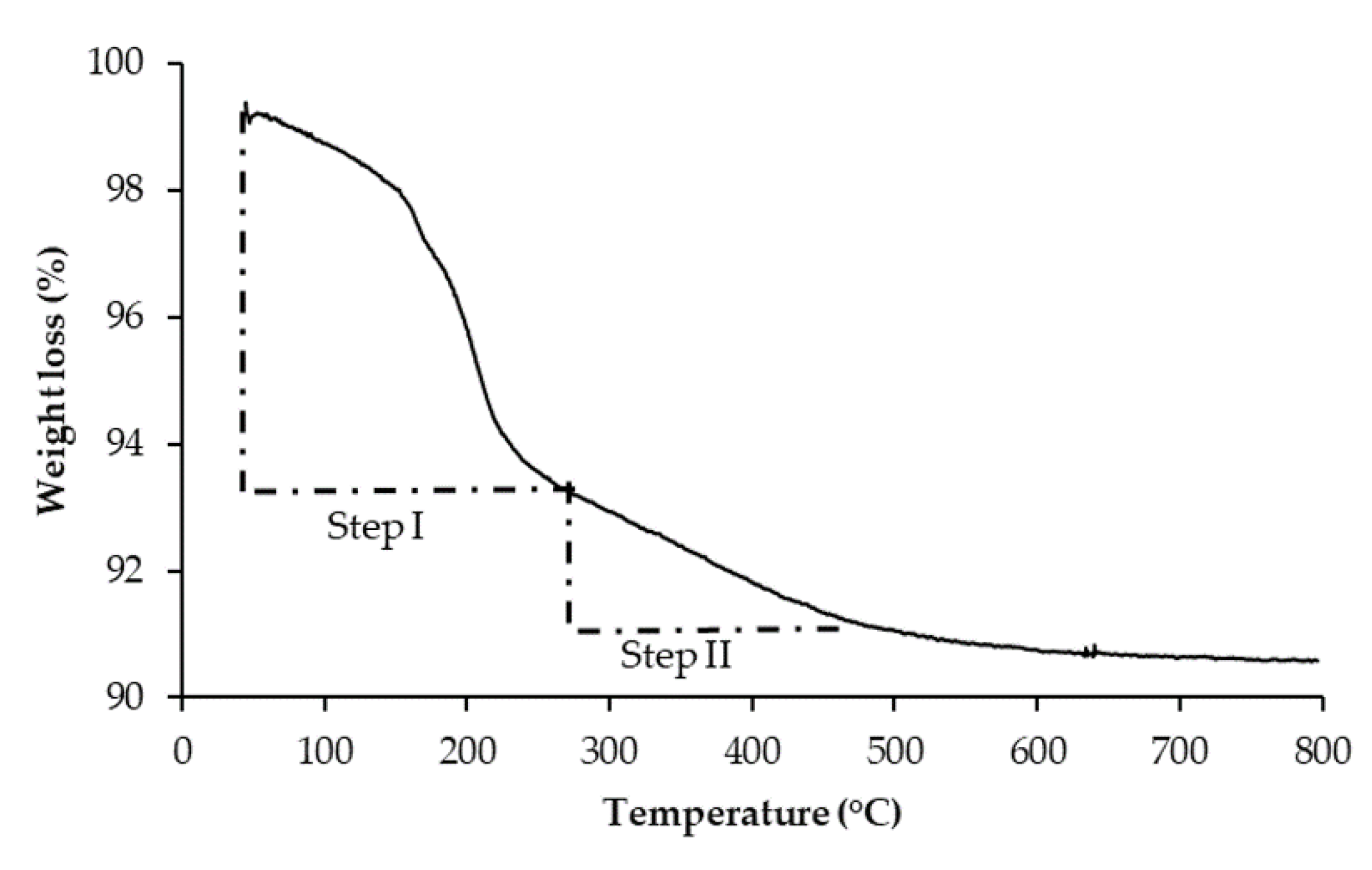
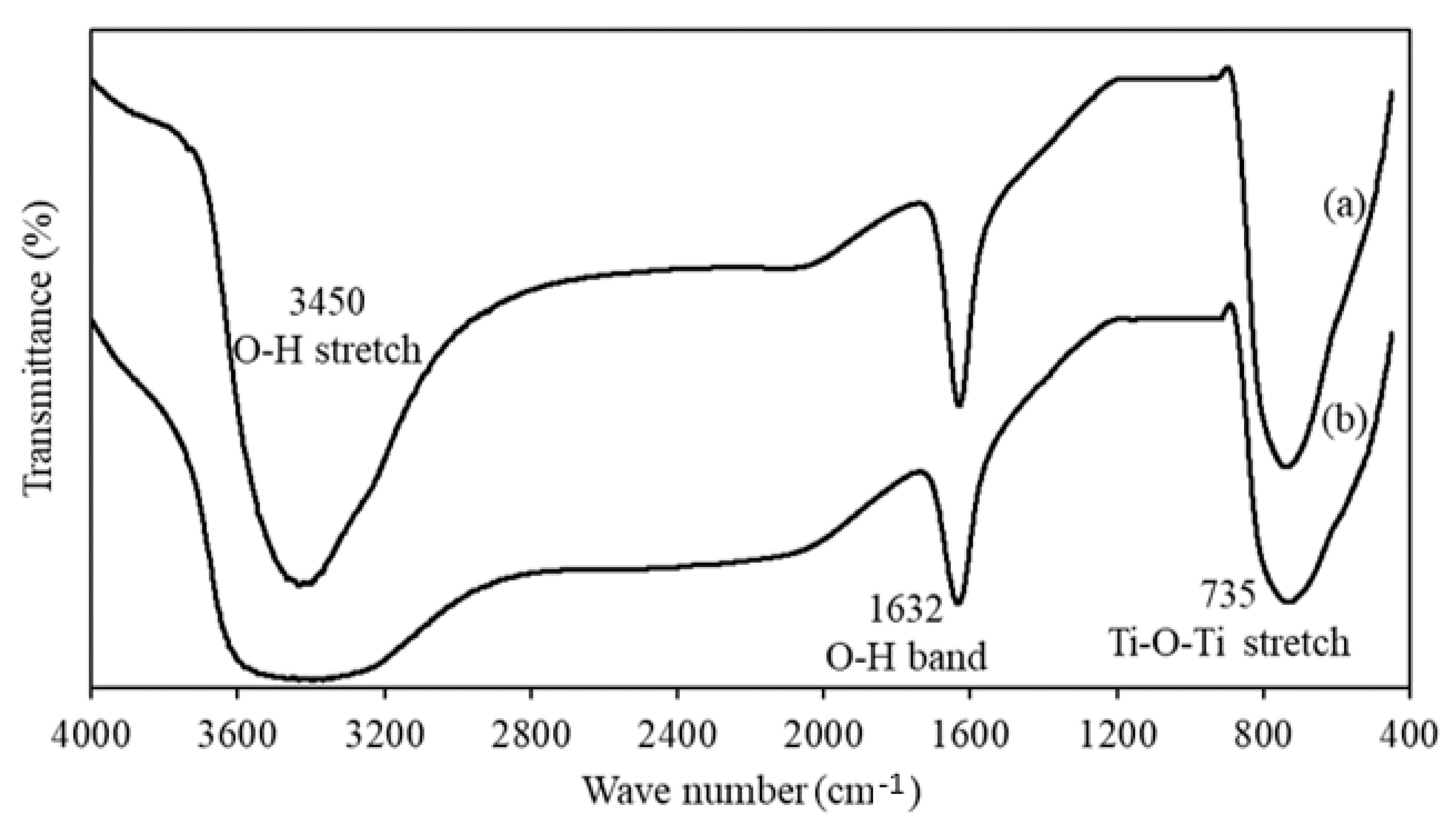
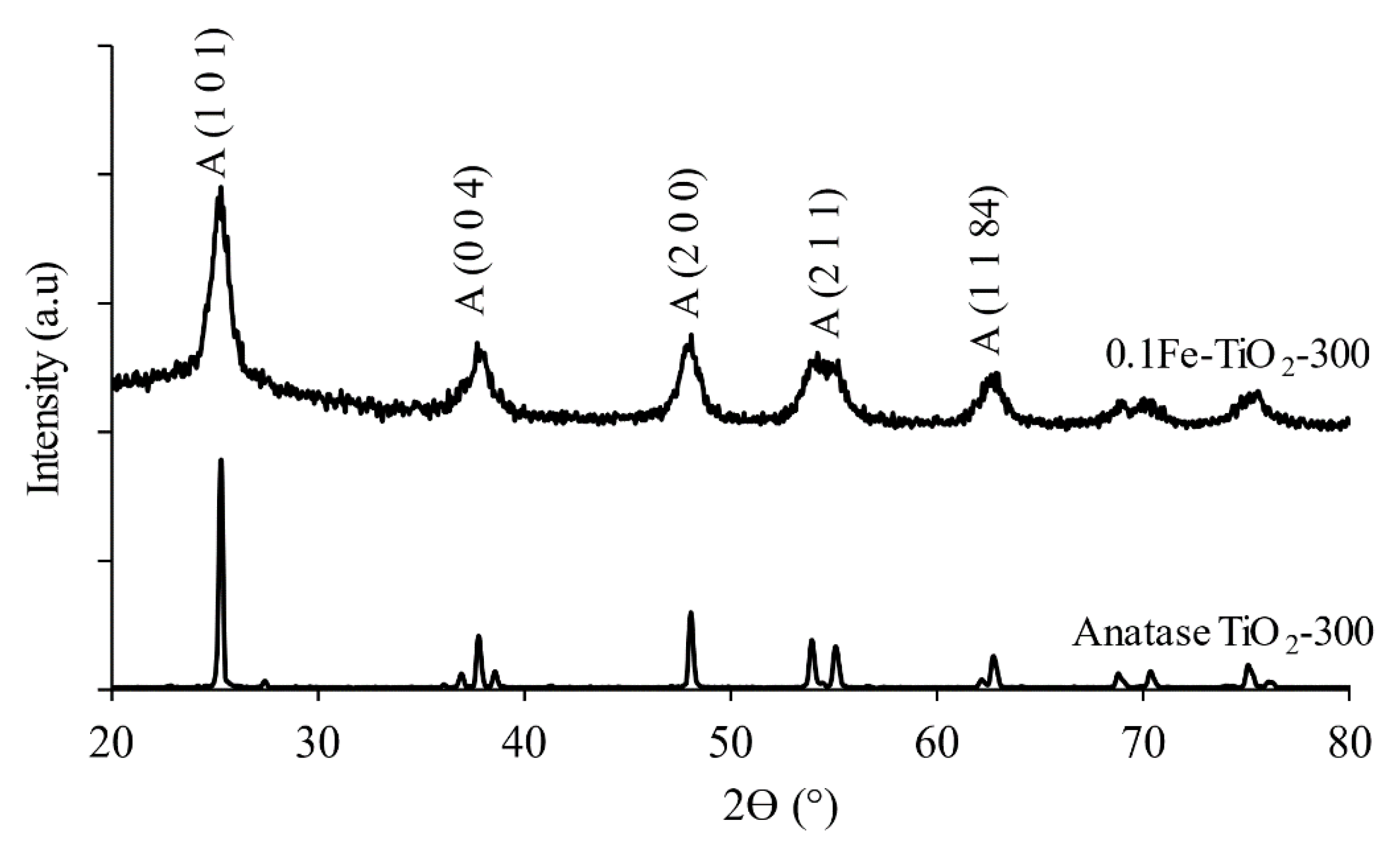


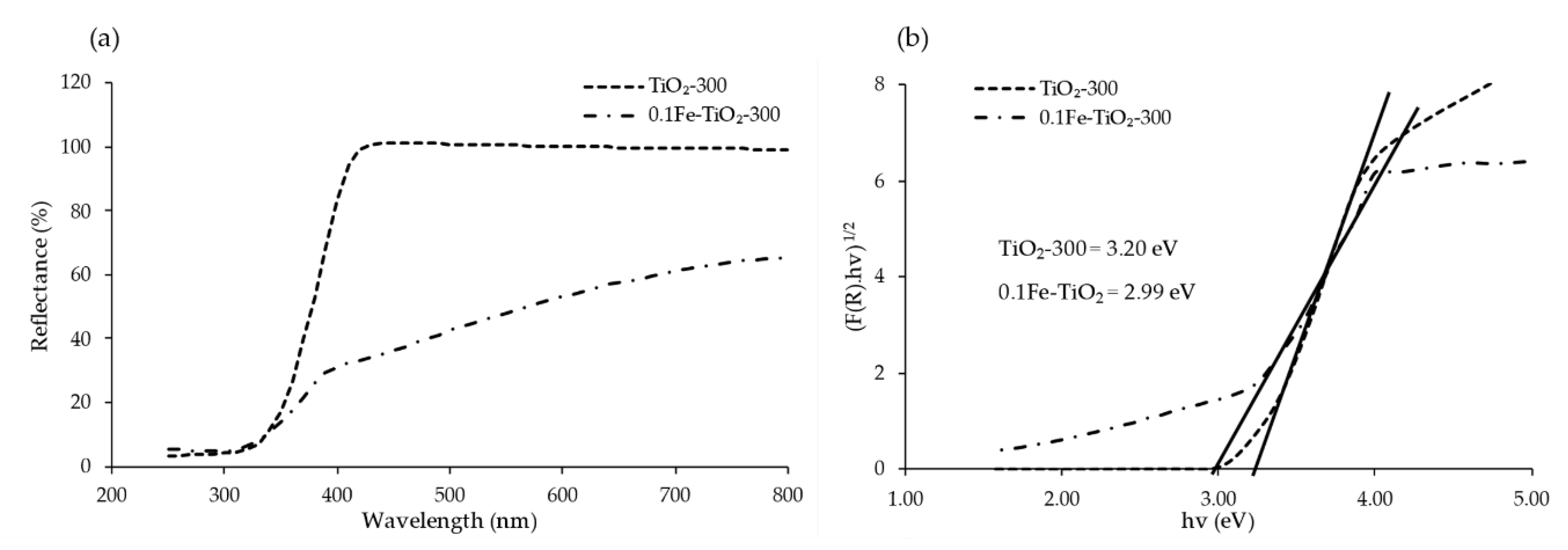
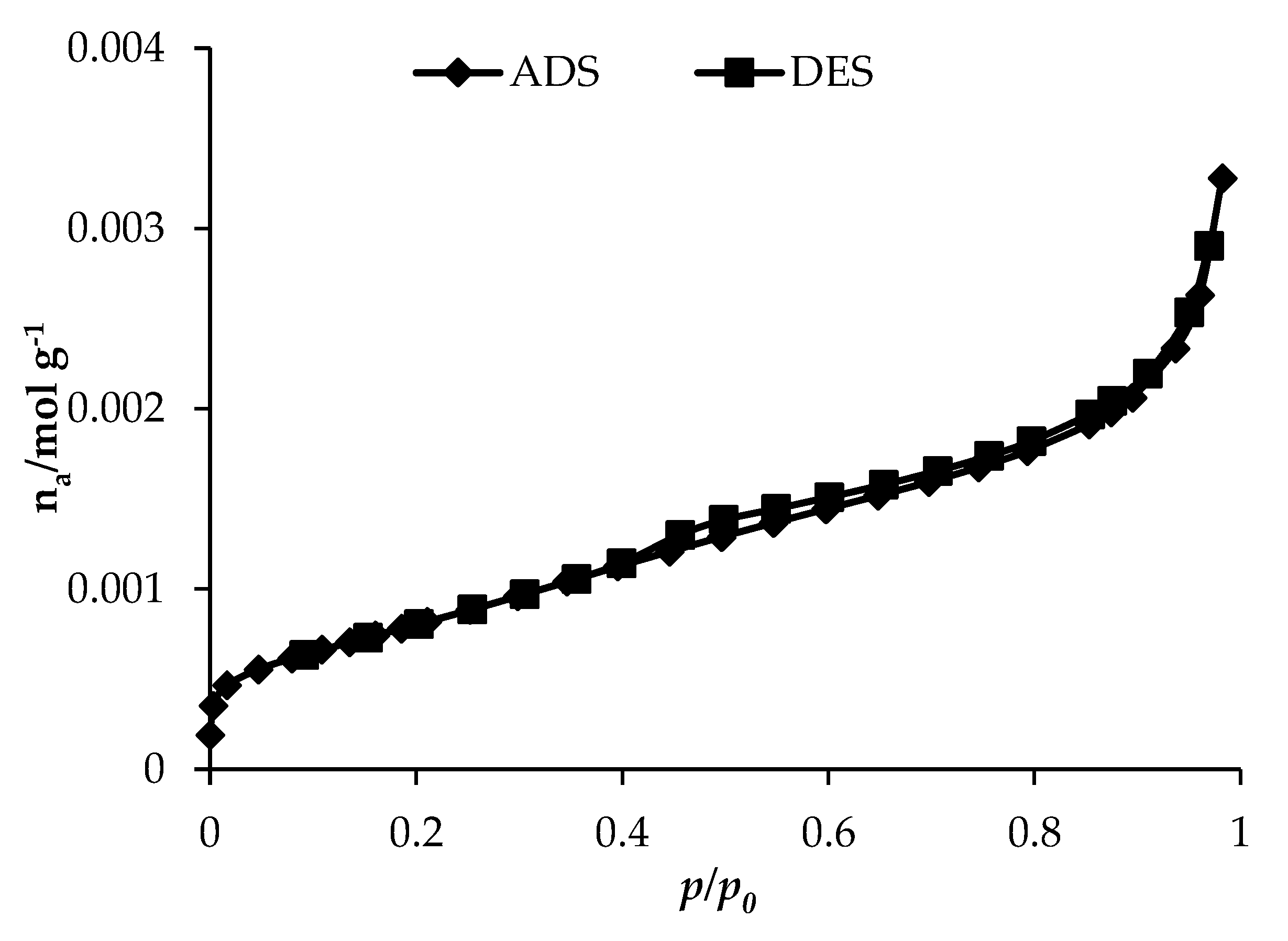

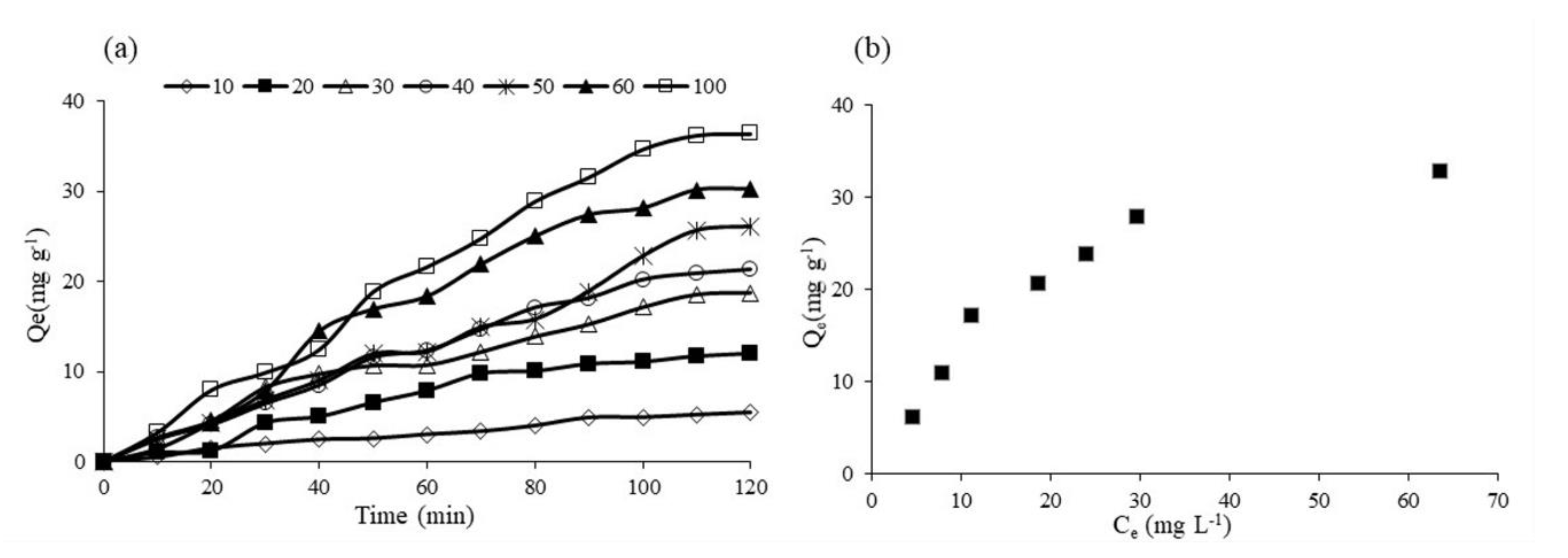
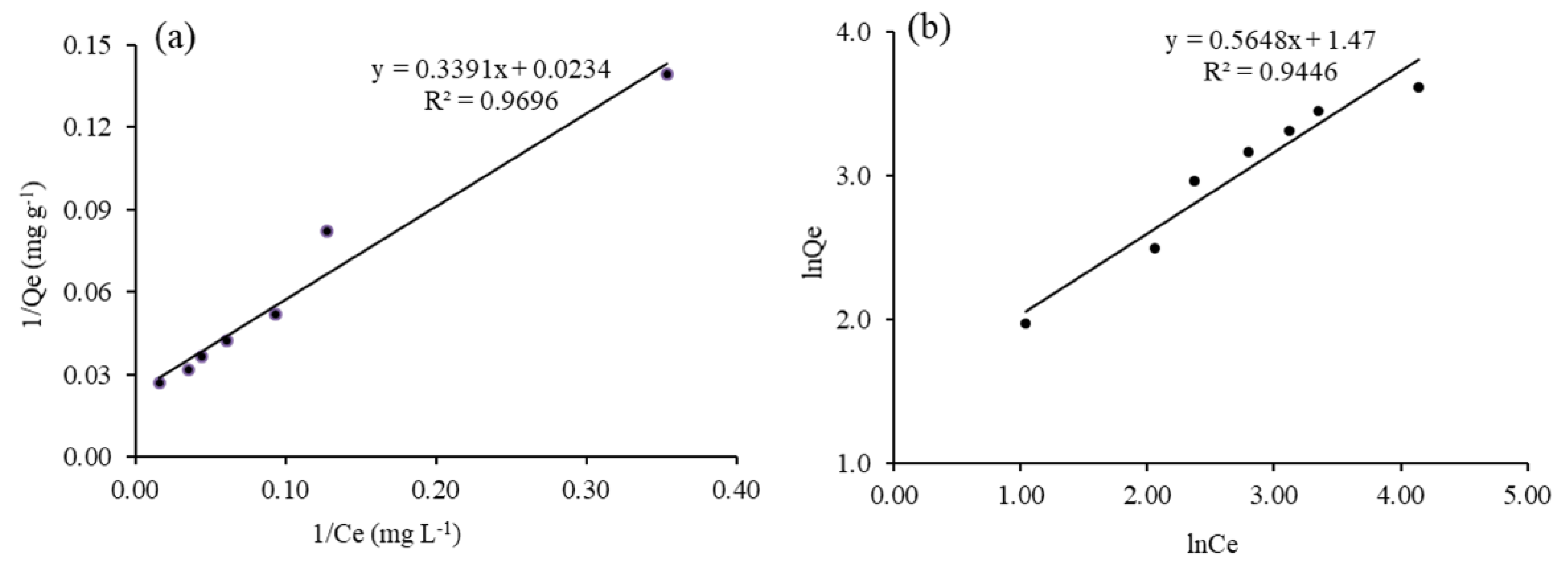
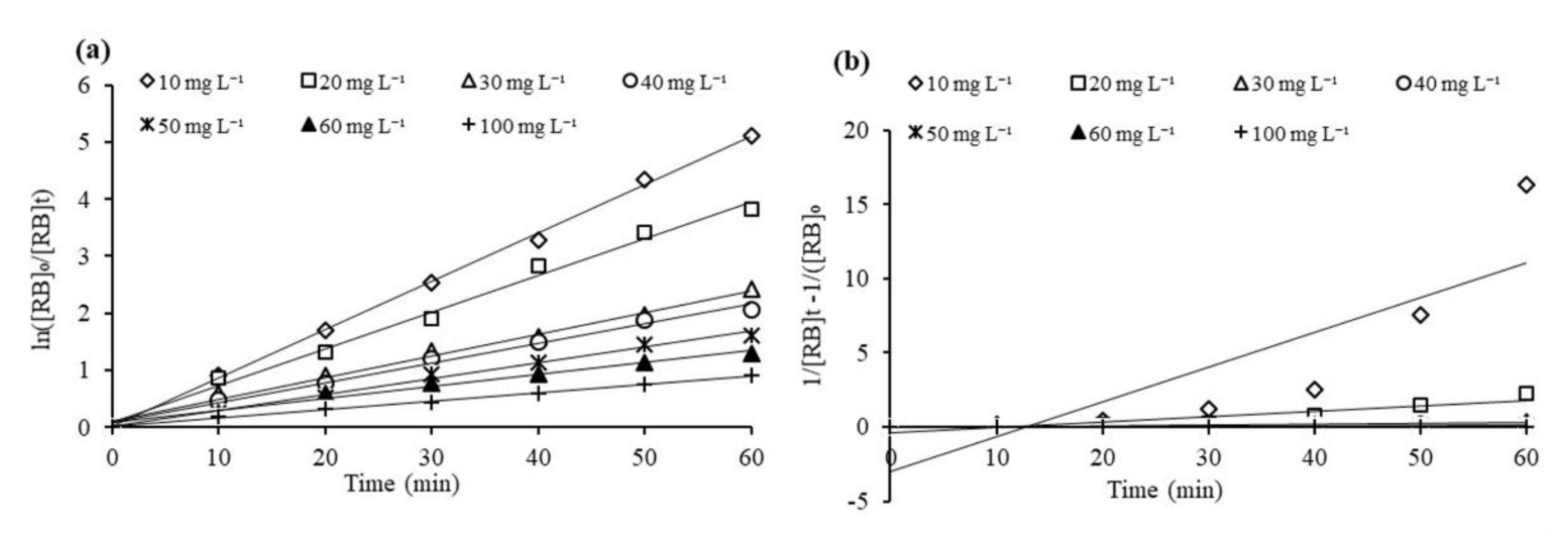
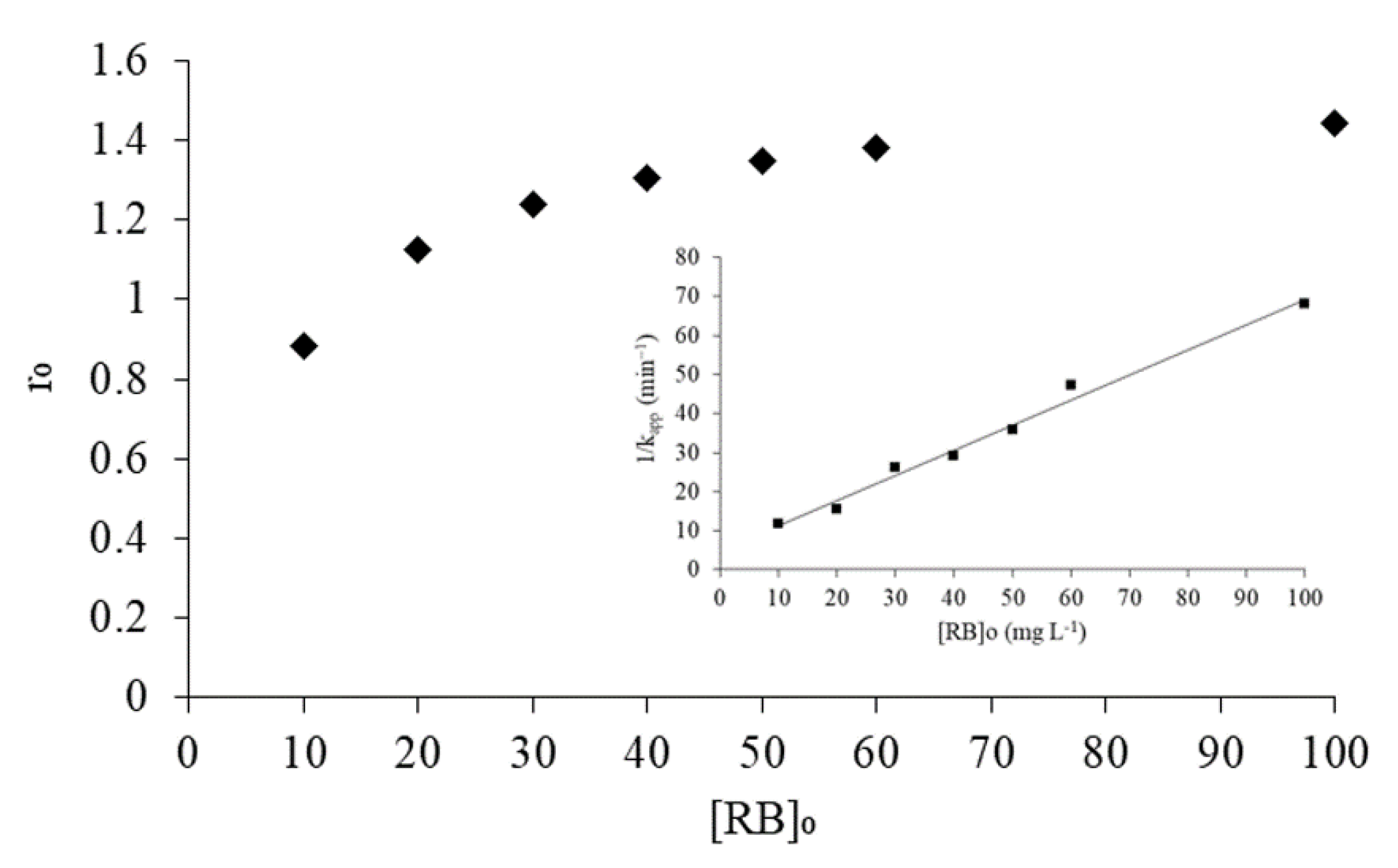

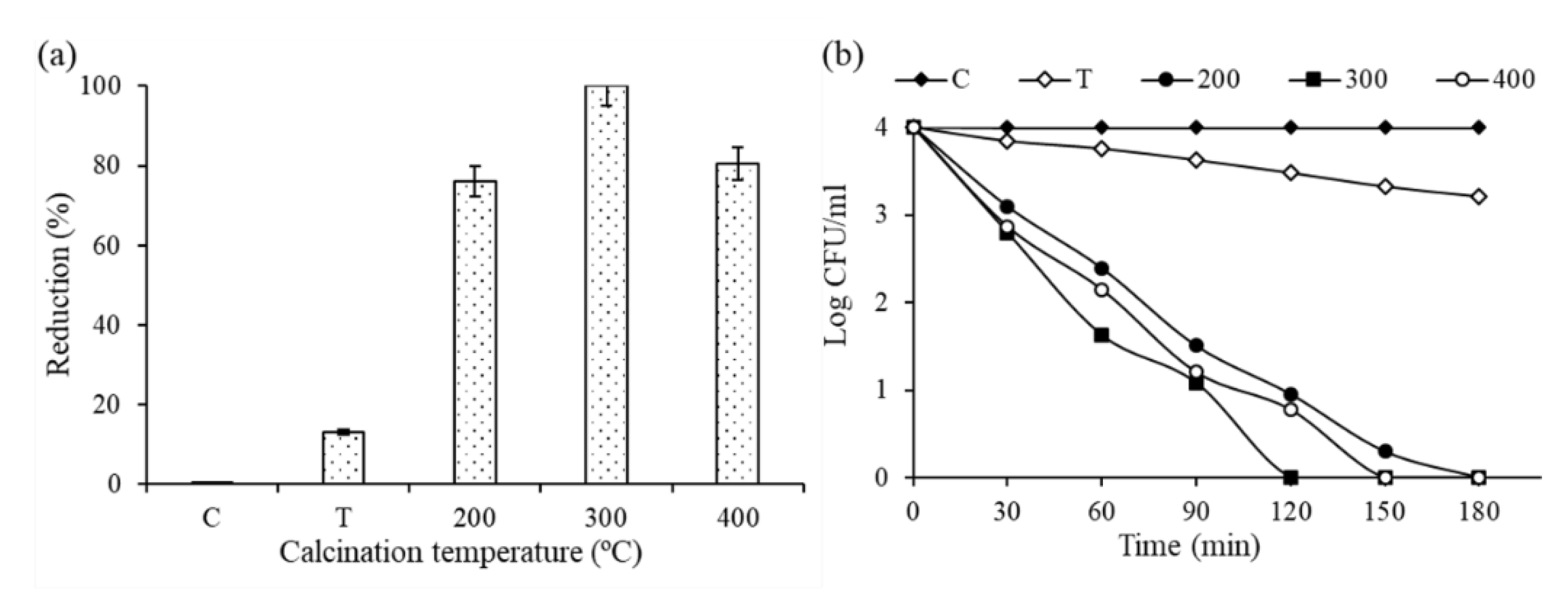
| Synthesis Method | Fe Contents | Calcination Temperature (°C) | Pollutant | Photocatalytic Efficiency and Reaction Time | Reference |
|---|---|---|---|---|---|
| Sol-gel | 5 wt% | 500 | Methylene blue | 55.45% 240 min | [24] |
| Sol-gel-Hydrothermal | 0.40 wt% Fe-TiO2 | 200 | active yellow XRG | 88.8% (UV), 64.1% (Vis) 60 min | [15] |
| Sol-gel | 3.0 mol% | 400 | E. coli | 100% inactivation 120 min | [25] |
| Sol-gel | 3.0 mol% | 500 | Rhodamine 6G | 100% 40 min | [26] |
| Sol-gel | 1.0Fe (at%) | 550 | methyl orange s | >80% 120 min | [27] |
| Sol-gel | 0.15 mol% | 500 | RB5 | 100 60 min | [14] |
| Hydrothermal | Fe:Ti, 1:3 | N.C | RB5 | 90% 120 min | [28] |
| Sol-gel | 1.62% | 450 | RB5 | 100% 60 min | [29] |
| Co-precipitation | 500 | RB5 | 91% 60 min | [20] |
| Isotherm Model | Plot | Parameters | R2 |
|---|---|---|---|
| Langmuir | 1/Qe vs 1/Ce | Qm = 42 mg g−1 | 0.9696 |
| Kads = 0.0079 L mg−1 | |||
| Freundlich | lnQe vs lnCe | n = 1.78 | 0.9446 |
| KF = 29.51 mg g−1 |
Publisher’s Note: MDPI stays neutral with regard to jurisdictional claims in published maps and institutional affiliations. |
© 2021 by the authors. Licensee MDPI, Basel, Switzerland. This article is an open access article distributed under the terms and conditions of the Creative Commons Attribution (CC BY) license (http://creativecommons.org/licenses/by/4.0/).
Share and Cite
Khan, M.S.; Shah, J.A.; Riaz, N.; Butt, T.A.; Khan, A.J.; Khalifa, W.; Gasmi, H.H.; Latifee, E.R.; Arshad, M.; Al-Naghi, A.A.A.; et al. Synthesis and Characterization of Fe-TiO2 Nanomaterial: Performance Evaluation for RB5 Decolorization and In Vitro Antibacterial Studies. Nanomaterials 2021, 11, 436. https://doi.org/10.3390/nano11020436
Khan MS, Shah JA, Riaz N, Butt TA, Khan AJ, Khalifa W, Gasmi HH, Latifee ER, Arshad M, Al-Naghi AAA, et al. Synthesis and Characterization of Fe-TiO2 Nanomaterial: Performance Evaluation for RB5 Decolorization and In Vitro Antibacterial Studies. Nanomaterials. 2021; 11(2):436. https://doi.org/10.3390/nano11020436
Chicago/Turabian StyleKhan, Muhammad Saqib, Jehanzeb Ali Shah, Nadia Riaz, Tayyab Ashfaq Butt, Asim Jahangir Khan, Walid Khalifa, Hatem Hassin Gasmi, Enamur Rahim Latifee, Muhammad Arshad, Ahmed Abdullah Alawi Al-Naghi, and et al. 2021. "Synthesis and Characterization of Fe-TiO2 Nanomaterial: Performance Evaluation for RB5 Decolorization and In Vitro Antibacterial Studies" Nanomaterials 11, no. 2: 436. https://doi.org/10.3390/nano11020436
APA StyleKhan, M. S., Shah, J. A., Riaz, N., Butt, T. A., Khan, A. J., Khalifa, W., Gasmi, H. H., Latifee, E. R., Arshad, M., Al-Naghi, A. A. A., Ul-Hamid, A., Arshad, M., & Bilal, M. (2021). Synthesis and Characterization of Fe-TiO2 Nanomaterial: Performance Evaluation for RB5 Decolorization and In Vitro Antibacterial Studies. Nanomaterials, 11(2), 436. https://doi.org/10.3390/nano11020436









